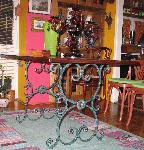WROUGHT IRON FOR THE LAST 50 YEARS
10.12.2012
 If you come across some competition or seminar in America which is held by their blacksmiths, be assured that the ambient, technology and scenery will get you back for more than 100 years. It would be as if you were in Schonlaterngasse in Wien, in one of the oldest and best-known forges where the hammer and anvil had been the main technological tools. There were also many manual settings, blacksmith's pliers, patterns for designing artistic details and, of course, about twenty blacksmith's fires.
If you come across some competition or seminar in America which is held by their blacksmiths, be assured that the ambient, technology and scenery will get you back for more than 100 years. It would be as if you were in Schonlaterngasse in Wien, in one of the oldest and best-known forges where the hammer and anvil had been the main technological tools. There were also many manual settings, blacksmith's pliers, patterns for designing artistic details and, of course, about twenty blacksmith's fires. When somebody says: “Strike while the iron is hot,” a blacksmith means – while it is white-hot. The white colour of heated iron shows that it has a temperature of 1,200 – 1,300 degrees. Then it is soft enough to be formed without great effort. You can see the results of this skill at every tourist site in Wien. It is so perfect that it seems unattainable.
The American Blacksmiths’ Association continues the tradition of artistic forging where technological innovations are excluded. This group has many members, true enthusiasts of this craft, which outgrew the blacksmith’s-horse shoe’s job in America and which was one of the most important crafts for a long time in America’s early history.
There are, of course, many modern blacksmith’s shops, just like everywhere in the world, where the latest technological innovations are applied.
Rapid development of industry has drawn technology near us and now it is relatively easy to practice the blacksmith’s craft. A hundred years ago, it was hard and expensive work which could be paid only by chosen ones. The craft was learnt for a long time and everything was done manually and slowly. People are still interested in the question whether iron is made manually or with machines because they often cannot see the difference and so confusions are often made. It would be as if manually mixed concrete was better than the one from a mixer or manual painting was better than painting with a compressor, etc.
Different technological innovations have brought a revolution in this craft: welding protected with CO2, gas and induction heating, cutting with plasma and lasers, numerical directing, erosimats, water based paints, frequent regulators, encoders…
Wrought iron product chain
The wrought iron business has expanded so much in time, so that three groups which are mutually closely related can be distinguished.
The first group includes producers of machines which are used specifically in this business: blacksmith’s hammers, machines for engraving profiles using cold or hot procedures, machines for curving Archimedes’ spirals, machines for axis curving, water-presses for folding materials in tools, induction and gas furnaces for heating, machines for making baskets, etc.
The second group produces all parts which are used in the wrought iron business. It is a link between the producers of machines and locksmiths who produce the final product. Locksmiths are often equipped with a great number of machines which are produced by the first group, so they are independent to a great extent. The second group sells engraved materials, wrought and molten elements, constructions of these elements, paints, patina, pressed leaves and rosettes, catalogues, books, reprints of old editions for locksmiths who would like to try manual forging. In this group, there is a lot of mutual cooperation between the companies, so that the same products can be found at every producer, which shows that they have traded. However, they offer only a menu, while for à la carte, you must contact more specialized locksmith’s shops which can offer specialized service and small editions.
The third group, which has the greatest number of members, consists of locksmiths who closely cooperate with the producers of parts. The supply is great and outsiders often buy Italian parts which have just come from China. The quality is similar, but the price is much higher. The Italians use their tradition for promotion of cheap Chinese parts. The calculation is clear – it is much cheaper than to produce them themselves.
Tracing technological achievements, visiting fairs and education are of vital importance for success in this business.
Rust prevention
The greatest problem is rust prevention and some locksmiths deal with it applying zinc covering. The material which is used when dealing with wrought iron has to be soft, so in order to achieve that, crystal grids should be softened, which is also called stoking. It is done twice. This technological process, besides the fact that it gives softness to iron, makes also a surface layer, the so-called scale which falls off in time. It is the main cause why wrought iron rusts, because it falls off later on together with the applied paint. The solution is to clean iron using the technique of sandblasting before painting. The surface erodes a little during sandblasting, so it accepts paint much better.
Paints of high quality should be used – for the primer and the final ones. These are not at all nitro paints (they are used because they dry very quickly), but the oil ones – polyurethane, binary, water, etc. There are also techniques for testing the quality of paints, but I will come to that some other time.
There are also universal paints which substitute primers and final paints. There are also paints which are used on rusted surfaces. There are rust converters – liquids which make a protective layer together with rust. To avoid confusion, I must say that this is not rust inhibitor. One should adhere to the instruction that the next paint, used after the rust convertor, is applied only after 24 hours, if temperature conditions have been fulfilled. Opaque or glossy binary lacquers or various kinds of patina, which emphasize details on wrought iron, are often used over the final paint. It is evident that there is great ignorance about the usage of patina on our market. Sometimes, there is no correctly processed element on the Fair of Furniture.
Plastification is not good for protecting wrought iron.
Replicas
Replicas have become fashionable since a long time ago, not only when speaking of “Rolexes” and “Nikes”. We often come across box profiles instead of square materials, and aluminum moulds installed with a pop rivet or silicon can be seen on tops instead of wrought spikes. Some call this imitation of wrought iron and the name is funny just like the product itself. Whole welded constructions where the welded joints are covered with a clamp are bought from importers. These constructions cannot be protected with paint any more; they must be covered with zinc. Or they must be disassembled into parts, cleaned, sandblasted and then protected with final paint underneath the clamp. This step is often omitted and rust appeared with the first rains.
Covering gates with metal sheets is fashionable in some countries, and slowly it is becoming fashionable in Serbia. A problem arises because during the installment of sheets, the box of the gate’s frame is drilled with screws and in that way, water gets into the gate frame. The frame must be pressurized and separated from the part where the lock is. In that way, all the most sensitive parts will become long-lasting. In the contrary, there is no draft between the sheet and gate, moist remains there and then rust appears.
Wrought iron in interior
Fences, gates, railings for stairs and fences on balconies are outside and furniture is inside.
The approach to making furniture must be raised to a much higher level, because furniture is in constant contact with people and children. Anthropological measurements must be adhered to, the processing must be perfect so that nobody gets hurt and the paints must be environmentally friendly and resistant. Legs must have pads so that the floors could not be damaged.
Curtain rails, consoles and chandeliers request serious installment so that they would not fall down and hurt somebody. When speaking of chandeliers, it is very important to use cables of high quality (we recommend silicon ones) and ceramic bulb sockets.
This was a brief review on the basic facts of wrought iron, truths and delusions, without making any pretence to influence on your final choice. We have tried to be educational and well-intentioned, and we leave you to choose your own approach to this creative craft.
Author: Miroljub Jović, Eng.



